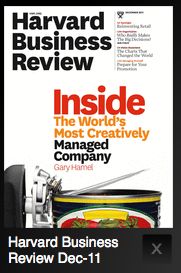Ignoring the Impossible
 In December, the cover of Harvard Business Review invited readers in to Gary Hamel’s feature article with the headline “Inside the World’s Most Creatively Managed Company.” This was an interesting headline, given that the real title of the article was “First, Let’s Fire All the Managers.” That one’s a little too provocative for the cover, I guess.
In December, the cover of Harvard Business Review invited readers in to Gary Hamel’s feature article with the headline “Inside the World’s Most Creatively Managed Company.” This was an interesting headline, given that the real title of the article was “First, Let’s Fire All the Managers.” That one’s a little too provocative for the cover, I guess.
But that points out an interesting problem here. “Creatively managed company” is inviting. We like that idea. That’s something we all could do. But firing all the managers? That’s impossible. That would never work. And that’s one of our biggest problems these days. When we KNOW something won’t work, we become blind to all the examples out there where it is working.
The story documents a company called Morning Star, the world’s largest tomato processor. They do $700 million in revenue a year, so this is not a small company. Two million tons of tomatoes annually. And they do it all without managers. As the article explains, in this company:
- No one has a boss.
- Employees negotiate responsibilities with their peers
- Everyone can spend the company’s money.
- Each individual is responsible for acquiring the tools needed to do his or her work.
- There are no titles and no promotions
- Compensation decisions are peer-based.
This is actually happening. And the company is successful, growing faster than the industry average. There’s a lot that goes into making those bullet points work, of course. And the article talks about it. I promise some blog posts that dig into these ideas, because they are consistent with some of the ideas we talk about in Humanize.
But for now, think about the bigger issue here: impossibility. When it comes to management and leadership, I have no tolerance for the idea that something is impossible. Management is a relatively new phenomenon, and in its short history it has seen very few changes or innovations. We say things are “impossible” mostly because they have never been done before, but given the tiny range of what has been done in “management,” that it is a horrible excuse.
I feel like we should come clean and admit that none of us really knows what we’re doing when it comes to management. We’ve had our experiences and many of us have built successful workplaces, and a lot of what we’ve done is great–but we really can’t say what is possible or impossible. And while I don’t hold up one exception as a perfect “model” to be copied by everyone, I do get excited when I see the impossible happening in real life. It’s inspiration for me to try doing things differently. Because that’s what our workplaces desperately need right now.
_____________________
Humanize: How People-centric Organizations Succeed in a Social World takes on the topic of trust in great detail. Buy the book today.

4 Comments
Ignoring the Impossible | Humanize | Scoop.it
[…] background-color:#222222; background-repeat : repeat; } http://www.jamienotter.com – Today, 8:47 […]
Ignoring the Impossible | Enterprise 2.0 | Scoop.it
[…] background-position: 50% 0px; background-color:#222222; background-repeat : no-repeat; } http://www.jamienotter.com – Today, 2:28 […]
Gareth Jones
Hi Jamie. Great post and thoughts. HBR seem to have taken a new outlook, this article in December and the more recent issue dominated with the “happiness as a business model” angle which touched on many of the same themes. It is good to see and not before time. But you touch on the theme of impossibility which is particularly prevalent in management thinking. i guess there are many examples in life of things that challenge convention and go against the grain, yet deliver superior results. At first we ignore them, then say it wont work/last/be good for us. Then we reach the tipping point.
The truth is that the tipping point on this one seems to be taking a long time. Morning Start is not unique and Im sure you are aware of Semco, who took this approach 20+ years ago. Ricardo Semler was proclaimed and idiot back then but look what transpired.
As an HR pro turned commercial person by trade, I meet a lot of people to tell me this cant be done. But i know differently. Unfortunately im in the minority right now. Ironic though isn’t it that the real majority that matters – the people being managed, the rank and file – know that the morning star/semco way IS the best way.
Eric D. Brown - Links for February 19 2012
[…] Ignoring the Impossible by Jamie Notter […]